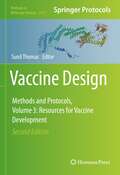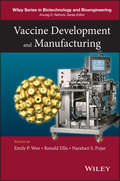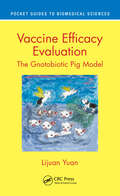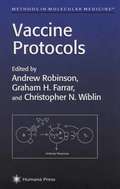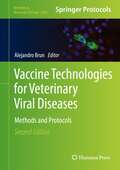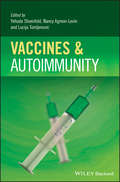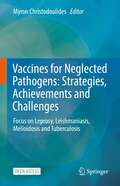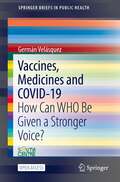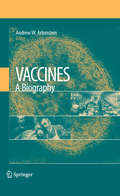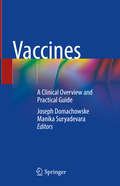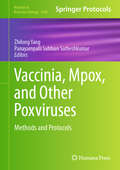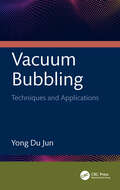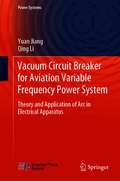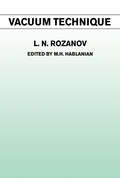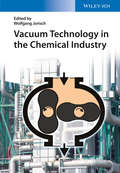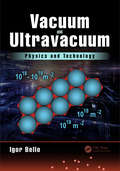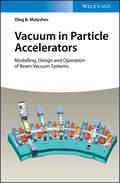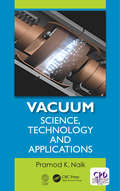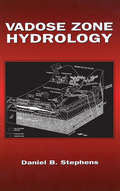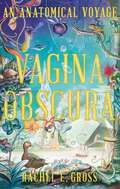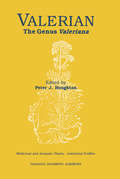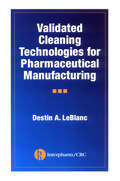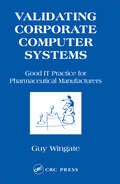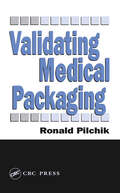- Table View
- List View
Vaccine Design: Methods and Protocols, Volume 3. Resources for Vaccine Development (Methods in Molecular Biology #2412)
by Sunil ThomasThis volume provides a practical guide providing step-by-step methods and protocols on vaccine development and production. Divided into three volumes, Volume 3: Resources for Vaccine Development guides readers through chapters on vaccine adjuvants, vaccine vectors, production, vaccine delivery systems, vaccine bioinformatics, vaccine regulation, and intellectual property. Written in the format of the highly successful Methods in Molecular Biology series, each chapter includes an introduction to the topic, lists necessary materials and reagents, includes tips on troubleshooting and known pitfalls, and step-by-step, readily reproducible protocols. Authoritative and practical, Vaccine Design: Methods and Protocols, Second Edition, Volume 3: Resources for Vaccine Development aims to be a useful practical guide to researchers to help further their study in this field.
Vaccine Development and Manufacturing
by Narahari S. Pujar Ronald Ellis Emily P. WenVaccine Manufacturing and Production is an invaluable reference on how to produce a vaccine - from beginning to end - addressing all classes of vaccines from a processing, production, and regulatory viewpoint. It will provide comprehensive information on the various fields involved in the production of vaccines, from fermentation, purification, formulation, to regulatory filing and facility designs. In recent years, there have been tremendous advances in all aspects of vaccine manufacturing. Improved technology and growth media have been developed for the production of cell culture with high cell density or fermentation. Vaccine Manufacturing and Production will serve as a reference on all aspects of vaccine production by providing an in-depth description of the available technologies for making different types of vaccines and the current thinking in facility designs and supply issues. This book will provide insight to the issues scientists face when producing a vaccine, the steps that are involved, and will serve as a reference tool regarding state-of-the-art vaccine manufacturing technologies and facility set-up.Highlights include:Comprehensive coverage of vaccine production : from a process point of view- fermentation to purification to formulation developments; from a production point of view - from facility design to manufacturing; and from a regulatory point of view - requirements from government agenciesAuthors from different major pharmaceutical and biotechnology companiesDescribes the challenges and issues involved in vaccine production and manufacturing of the different classes of vaccines, an area not covered by other books currently on the market
Vaccine Efficacy Evaluation: The Gnotobiotic Pig Model (Pocket Guides to Biomedical Sciences)
by Lijuan YuanTesting the immunogenicity, protective efficacy and safety in animal models is a crucial step in vaccine development. Pigs raised in germ-free environments, called gnotobiotic (Gn) pigs, are one of the most useful animal models for testing vaccines. The Gn pig model is a widely accepted model for studying pathogenesis and immunity and an ideal model for pre-clinical testing for the safety and efficacy of enteric viral vaccines. Through these studies and others, the Gn pig model has been established as the most reliable animal model for pre-clinical evaluation of human rotavirus and norovirus vaccines. This book provides detailed information on establishing Gn pig models, determining a proper virus inoculum pool and challenge dose, measuring protection and calculating efficacy, and delineating intestinal and systemic immune responses associated with the protection.Key Features Provides a natural history of human rotavirus and norovirus infection in Gn pigs Establishes the optimal virus challenge doses in Gn pigs for vaccine evaluation Evaluates various candidate rotavirus and norovirus vaccines Discusses human gut microbiota transplanted Gn pig models Documents the role of probiotics and rice bran as prophylactics and vaccine adjuvants
Vaccine Protocols
by Andrew P. Robinson Christopher N. Wiblin Graham H. FarrarExpert practitioners present a comprehensive approach to vaccine development, production, and assessment that can be adapted successfully to any vaccine. Their approach not only includes state-of-the-art techniques for developing live viral and bacterial vectors, expressing foreign vaccine antigens, and producing peptide and conjugate vaccines, but also offers advice and guidance on clinical trials and regulatory requirements. Additional techniques describe such powerful tools as the use of adjuvants, freeze drying vaccines, microencapsulation of vaccines, the full assessment of immunogenicity and potency of vaccines in animal models, and the creation of DNA vaccines, chimeric proteins, and recombinant toxoids.
Vaccine Technologies for Veterinary Viral Diseases: Methods and Protocols (Methods in Molecular Biology #2465)
by Alejandro BrunThis second edition includes a collection of antigen production and delivery strategies for vaccine development in veterinary species. New and updated chapters guide readers through protocols for antigen production, experimental antigen delivery and the analysis of immune responses upon vaccination. Written in the format of the highly successful Methods in Molecular Biology series, each chapter includes an introduction to the topic, lists necessary materials and reagents, includes tips on troubleshooting and known pitfalls, and step-by-step, readily reproducible protocols. Authoritative and cutting-edge, Vaccine Technologies for Veterinary Viral Diseases: Methods and Protocols, Second Edition aims to be a useful and practical guide to researches to help further their study in this field.
Vaccines and Autoimmunity
by Yehuda Shoenfeld Nancy Agmon-Levin Lucija TomljenovicIn light of the discovery of Autoimmune Syndrome Induced by Adjuvants, or ASIA, Vaccines and Autoimmunity explores the role of adjuvants - specifically aluminum in different vaccines - and how they can induce diverse autoimmune clinical manifestations in genetically prone individuals. Vaccines and Autoimmunity is divided into three sections; the first contextualizes the role of adjuvants in the framework of autoimmunity, covering the mechanism of action of adjuvants, experimental models of adjuvant induced autoimmune diseases, infections as adjuvants, the Gulf War Syndrome, sick-building syndrome (SBS), safe vaccines, toll-like receptors, TLRS in vaccines, pesticides as adjuvants, oil as adjuvant, mercury, aluminum and autoimmunity. The following section reviews literature on vaccines that have induced autoimmune conditions such as MMR and HBV, among others. The final section covers diseases in which vaccines were known to be the solicitor - for instance, systemic lupus erythematosus - and whether it can be induced by vaccines for MMR, HBV, HCV, and others. Edited by leaders in the field, Vaccines and Autoimmunity is an invaluable resource for advanced students and researchers working in pathogenic and epidemiological studies.
Vaccines for Neglected Pathogens: Focus on Leprosy, Leishmaniasis, Melioidosis and Tuberculosis
by Myron ChristodoulidesThis book reviews successes and (remaining) challenges in vaccine development for the selected Neglected Tropical Diseases (NTD) of Leprosy, Leishmaniasis, Meliodoisis and Tuberculosis, which are a continuous burden for millions of people in affected areas worldwide. Written by frontline researchers, the volume deep-dives into different vaccine strategies, provides biotechnological background information and also tackles animal models in NTD therapeutics research. By bringing together state-of-the-art expert knowledge, the book contributes to the aim of ultimately ending the epidemics of neglected tropical diseases, complying with UN Sustainable Development Goal 3, Health and Well-Being.The volume highlights the activities of the research network VALIDATE (VAccine deveLopment for complex Intracellular neglecteD pAThogEns), funded by the Medical Research Council in the UK. The four NTDs discussed in the book were selected as these are in the focus of VALIDATE’s research.The book targets scientists and clinicians working on NTDs, as well as all readers with a background in biomedicine and interest in vaccine development.This is an open access book.
Vaccines, Medicines and COVID-19: How Can WHO Be Given a Stronger Voice? (SpringerBriefs in Public Health)
by Germán VelásquezThis open access book is a collection of research papers on COVID-19 by Germán Velásquez from 2020 and early 2021 that help to answer the question: How can an agency like the World Health Organization (WHO) be given a stronger voice to exercise authority and leadership? The considerable health, economic and social challenges that the world faced at the beginning of 2020 with COVID-19 continued and worsened in many parts of the world in the second-half of 2020 and into 2021. Many of these countries and nations wanted to explore COVID-19 on their own, sometimes without listening to the main international health bodies such as WHO, an agency of the United Nations system with long-standing experience and vast knowledge at the global level and of which all countries in the world are members. In this single volume, the chapters present the progress of thinking and debate — particularly in relation to drugs and vaccines — that would enable a response to the COVID-19 pandemic or to subsequent crises that may arise. Among the topics covered:COVID-19 Vaccines: Between Ethics, Health and EconomicsMedicines and Intellectual Property: 10 Years of the WHO Global StrategyRe-thinking Global and Local Manufacturing of Medical Products After COVID-19Rethinking R&D for Pharmaceutical Products After the Novel Coronavirus COVID-19 ShockIntellectual Property and Access to Medicines and VaccinesThe World Health Organization Reforms in the Time of COVID-19Vaccines, Medicines and COVID-19: How Can WHO Be Given a Stronger Voice? is essential reading for negotiators from the 194 member countries of the World Health Organization (WHO); World Trade Organization (WTO) and World Intellectual Property Organization (WIPO) staff participating in these negotiations; academics and students of public health, medicine, health sciences, law, sociology and political science; and intergovernmental organizations and non-governmental organizations that follow the issue of access to treatments and vaccines for COVID-19.
Vaccines: A Biography
by Andrew W. ArtensteinThe History and Biography of Vaccines against Infectious Diseases is a multi-authored book, written for an academic audience but accessible to a general readership as well. The book examines the human stories that underlie the development of vaccines against infectious diseases. Each chapter traces the lineage of a vaccine by examining the people behind the scientific hypotheses and discoveries that led to vaccine breakthroughs. These stories are firmly anchored in their historical context, as the "biography" of a vaccine generally has its origins in a medical problem rooted within a social context that subsequently engages scientists and enlists others in the eventual solution. A prominent theme woven throughout the book is the interdependence of incremental scientific advances and investigators on one another and how such advances ultimately led to practical, preventive solutions to major public health problems in society. Additionally, the human aspect of various pivotal events in the histories of specific vaccines are illustrated--this includes scientific and political hurdles and details of clinical trial controversies. In this fashion the work interweaves scientific themes, personal stories of those involved, and the sociohistorical context in which they worked in a manner that illustrates their inter-relatedness and provides the reader with exciting accounts of these advances.
Vaccines: A Clinical Overview and Practical Guide
by Joseph Domachowske Manika SuryadevaraThis book is designed to provide easy-to-read and basic information about vaccines for those undertaking a vaccine course or for medical providers seeking to improve their skills. Written by expert medical educators in the areas of infectious diseases, medical microbiology, and pediatrics, this book begins by establishing the fundamentals of vaccines such as what constitutes a vaccine, how they are manufactured and composed, how they are tested for safety and efficacy, and how vaccine recommendations are developed and conveyed to health care providers and their patients. The book then explains the composition, safety profile, effectiveness, and current recommendations for use of every available vaccine, alphabetized by infection. The concluding section illuminates practical concerns every vaccinating clinician experiences, including vaccine confidence and hesitancy, misconceptions, and patient communication. Vaccines: A Clinical Overview and Practical Guide is an excellent learning tool for all students and providers administering vaccines to patients, including infectious disease specialists and other internal medicine subspecialists, pediatricians, geriatricians, as well as all other primary care physicians, nurse practitioners, physician’s assistants, and nurses.
Vaccinia, Mpox, and Other Poxviruses: Methods and Protocols (Methods in Molecular Biology #2860)
by Zhilong Yang Panayampalli Subbian SatheshkumarThis detailed volume covers new and classic methods for vaccinia virus (the prototype poxvirus) but also extends to methods and protocols specifically tailored for mpox virus, lumpy skin disease virus, and myxoma virus. As these viruses continue to expand their territories, research into the impact of poxviruses on human and animal health, as well as investigating vaccine vectors and oncolytic virotherapy, becomes more important, and this book provides a thorough resource for this area of study. Written for the highly successful Methods in Molecular Biology series, chapters include introductions to their respective topics, lists of the necessary materials and reagents, step-by-step and readily reproducible laboratory protocols, and tips on troubleshooting and avoiding known pitfalls. Authoritative and up-to-date, Vaccinia, Mpox, and Other Poxviruses: Methods and Protocols serves as an ideal resource for virologists working in this vital section of the field.
Vacuum Bubbling: Techniques and Applications
by Yong Du JunVacuum Bubbling introduces the background and applications for generating bubbles under a vacuum condition, accomplished through depressurization without the need to heat water. It presents the advantage of utilizing vapor bubble in deaeration applications because the diffusion for degassing happens between the water body and micro vapor bubbles without the need of membrane or packing.Instead of relying on massive heating, vacuum bubbling focuses on depressurization down to the level of saturated vapor pressure or below to secure vapor bubbles with virtually zero dissolved non-condensable gases, including oxygen. The book considers prospective applications, such as extracting high-oxygen-content air from water for underwater breathing, pretreatment of aircraft fuel before being pumped into a fuel tank system, and probable desalination applications through massive bubbling combined with low-grade renewable energy.The book is intended for researchers in thermal fluids, heat and mass transfer, process engineering, and water treatment fields and industry professionals working in power generation, plant and process engineering, transportation, and energy.
Vacuum Circuit Breaker for Aviation Variable Frequency Power System: Theory and Application of Arc in Electrical Apparatus (Power Systems)
by Qing Li Yuan JiangThis book introduces the concepts of more electric aircraft and aviation electrical appliances, as well as the aviation experimental platform of vacuum switches, the interruption characteristics, frequency characteristics and post-arc breakdown characteristics of intermediate frequency vacuum switches, etc. It is the first monograph on protection electrical appliances, vacuum interrupter in aviation variable frequency power system. This book includes a lot of experimental process and chart analysis for readers to understand and provides references for practical engineering problems. This book could be used as references for engineers and technicians working on electric power systems in aircrafts.
Vacuum Technique
by L.N. RozanovVacuum technology finds itself in many areas of industry and research. These include materials handling, packaging, gas sampling, filtration, degassing of oils and metals, thin-film coating, electron microscopy, particle acceleration, and impregnation of electrical components. It is vital to design systems that are appropriate to the application, a
Vacuum Technology in the Chemical Industry
by Wolfgang JorischBased on the very successful German edition and a seminar held by the German Engineers` Association (VDI) on a regular basis for years now, this English edition has been thoroughly updated and revised to reflect the latest developments. It supplies in particular the special aspects of vacuum technology, applied vacuum pump types and vacuum engineering in the chemical, pharmaceutical and process industry application-segments. The text includes chapters dedicated to latest European regulations for operating in hazardous zones with vacuum systems, methods for process pressure control and regulation and leak detection. All of the authors work or did work at a selection of the most important German companies involved in vacuum technology, and their expertise is disseminated here for engineers working in vacuum technology, chemical process design, plant operation, and mechanical engineering.
Vacuum and Ultravacuum: Physics and Technology
by Igor BelloVacuum technology has enormous impact on human life in many aspects and fields, such as metallurgy, material development and production, food and electronic industry, microelectronics, device fabrication, physics, materials science, space science, engineering, chemistry, technology of low temperature, pharmaceutical industry, and biology. All decorative coatings used in jewelries and various daily products—including shiny decorative papers, the surface finish of watches, and light fixtures—are made using vacuum technological processes. Vacuum analytical techniques and vacuum technologies are pillars of the technological processes, material synthesis, deposition, and material analyses—all of which are used in the development of novel materials, increasing the value of industrial products, controlling the technological processes, and ensuring the high product quality. Based on physical models and calculated examples, the book provides a deeper look inside the vacuum physics and technology.
Vacuum in Particle Accelerators: Modelling, Design and Operation of Beam Vacuum Systems
by Oleg B. MalyshevA unique guide on how to model and make the best vacuum chambers Vacuum in Particle Accelerators offers a comprehensive overview of ultra-high vacuum systems that are used in charge particle accelerators. The book?s contributors ? noted experts in the field ? also highlight the design and modeling of vacuum particle accelerators. The book reviews vacuum requirements, identifies sources of gas in vacuum chambers and explores methods of removing them. In addition, Vacuum in Particle Accelerators offers an in-depth explanation of the control of the beam and the beam aperture. In the final part of the book, the focus is on the modelling approaches for vacuum chambers under various operating conditions. This important guide: -Offers a review of vacuum systems in charge particle accelerators -Contains contributions from an international panel of noted experts in the field -Highlights the systems, modelling, and design of vacuum particle accelerators -Includes information on vacuum requirements, beam-gas interactions, cryogenic temperatures, ion induced pressure instability, heavy ion machines -Presents the most up-to-date information on the topic for scientists and engineers Written for vacuum physicists, vacuum engineers, plasma physicists, materials scientists, and engineering scientists, Vacuum Particle Accelerators is an essential reference offering an in-depth exploration of vacuum systems and the modelling and design of charged particle accelerators.
Vacuum: Science, Technology and Applications
by Pramod NaikVacuum plays an important role in science and technology. The study of interaction of charged particles, neutrals and radiation with each other and with solid surfaces requires a vacuum environment for reliable investigations. Vacuum has contributed immensely to advancements made in nuclear science, space, metallurgy, electrical/electronic technology, chemical engineering, transportation, robotics and many other fields. This book is intended to assist students, scientists, technicians and engineers to understand the basics of vacuum science and technology for application in their projects. The fundamental theories, concepts, devices, applications, and key inventions are discussed.
Vadose Zone Hydrology
by Daniel B. StephensVadose Zone Hydrology describes the elements of the physical processes most often encountered by hydrogeologists and ground-water engineers in their vadose zone projects. It illustrates the application of soil physics to practical problems relevant to the characterization and monitoring of the vadose zone. It includes an introduction to physical processes, including basic flow theory, and provides examples of important field-scale processes that must be recognizable by hydrogeologists. Considerable attention is given to the concepts of recharge, including how it is most accurately evaluated in the vadose zone. Field and laboratory methods for characterizing hydraulic properties in the vadose zone are also covered, and case studies illustrating these methods are provided. New and emerging technologies for monitoring the vadose zone, particularly for the purpose of detecting contaminants, are highlighted. In the last section of the book, additional case studies are presented, demonstrating applications related to seepage detection, landfill monitoring, and soil gas investigations.This book is written from the perspective of hydrogeologists and is designed to be directly applicable and to maintain continuity and consistency between chapters. It will be an invaluable primer for environmental or geotechnical consultants, regulators, or students who have no prior formal academic training in unsaturated flow concepts. Because the text contains some of the latest advances in this field, it will be an excellent reference for geologists and engineers currently working on problems of vadose zone hydrology.
Vagina Obscura: An Anatomical Voyage
by Rachel E. GrossA myth-busting voyage into the female body. A camera obscura reflects the world back but dimmer and inverted. Similarly, science has long viewed woman through a warped lens, one focused narrowly on her capacity for reproduction. As a result, there exists a vast knowledge gap when it comes to what we know about half of the bodies on the planet. That is finally changing. Today, a new generation of researchers is turning its gaze to the organs traditionally bound up in baby-making—the uterus, ovaries, and vagina—and illuminating them as part of a dynamic, resilient, and ever-changing whole. Welcome to Vagina Obscura, an odyssey into a woman’s body from a fresh perspective, ushering in a whole new cast of characters. In Boston, a pair of biologists are growing artificial ovaries to counter the cascading health effects of menopause. In Melbourne, a urologist remaps the clitoris to fill in crucial gaps in female sexual anatomy. Given unparalleled access to labs and the latest research, journalist Rachel E. Gross takes readers on a scientific journey to the center of a wonderous world where the uterus regrows itself, ovaries pump out fresh eggs, and the clitoris pulses beneath the surface like a shimmering pyramid of nerves. This paradigm shift is made possible by the growing understanding that sex and gender are not binary; we all share the same universal body plan and origin in the womb. That’s why insights into the vaginal microbiome, ovarian stem cells, and the biology of menstruation don’t mean only a better understanding of female bodies, but a better understanding of male, non-binary, transgender, and intersex bodies—in other words, all bodies. By turns funny, lyrical, incisive, and shocking, Vagina Obscura is a powerful testament to how the landscape of human knowledge can be rewritten to better serve everyone.
Valerian: The Genus Valeriana
by Peter J. HoughtonValerian, is an up-to-date treatment of all aspects of this very important genus of plants, used in the traditional medicine of many parts of the world, particularly as a sedative. It includes material written by experts dealing with a variety of aspects including the ethnobotany, chemistry, pharmacology, cultivation, analysis and commercial aspects of Valeriana.This book will be of interest to all those concerned with the study and use of medicinal and aromatic plants and provides a comprehensive and contemporary overview of the status of this particular genus.
Validated Cleaning Technologies for Pharmaceutical Manufacturing
by Destin A. LeBlancWritten by an expert for those who must design validatable cleaning processes and then validate those processes, this book discusses interdependent topics from various technical areas and disciplines. It shows how each piece of the cleaning process fits into the validation program, making it more defensible in both internal quality audits and exter
Validating Corporate Computer Systems: Good IT Practice for Pharmaceutical Manufacturers
by Guy WingateOne of the biggest computer validation challenges facing pharmaceutical manufacturers is the large corporate system. This book provides practical information and advice on good IT practice and validation principles. Written by experts, it includes case studies on EDMSs, EAM systems, LIMSs, and MRP II systems.
Validating Medical Packaging
by Ronald PilchikAccording to the FDA Quality System Regulations, manufacturers must ensure that "device packaging and shipping containers are designed and constructed to protect the device from alteration or damage during the customary conditions of processing, storage, handling, and distribution." As specific as this statement is, the FDA does not provide instruc
